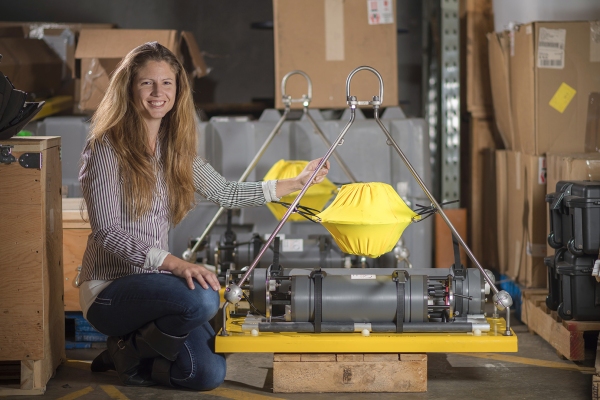The sounds made by whales and dolphins as they pass through New Zealand’s Cook Strait are to be recorded for the first time through a research project being undertaken by a NIWA scientist.
Marine ecologist Dr Kim Goetz is leading the project on NIWA’s flagship research vessel Tangaroa this week to deploy six acoustic moorings, made up of a string of hydrophones anchored to the sea floor in Cook Strait which will record the sounds of marine mammals for the next six months.
More than half the world’s whales and dolphins are found in New Zealand waters yet very little is known about their migration paths, their behaviour and where they go.
“This research has never been done this way in New Zealand, and for me, as a biologist, it’s exciting to be able to answer some of these really basic questions,” Dr Goetz says.
As well as the noises made by the animals, the acoustic moorings will also record the ambient soundscape of Cook Strait.
“Cook Strait is one of the most dynamic tidal cycles on the planet and a busy area for fishing vessels and ferries. There are a few other places in the world that are this noisy that also have large numbers of marine mammals.
“We’ll be able to quantify how loud it is and where the noise is coming from which has never been done here so that will be really interesting.”
The moorings
The moorings, four of which will be placed in deep water, and two in water less than 250m deep, will record the low frequencies of baleen whales and other migratory whales, as well as the high frequencies of the beaked whales and any dolphin or porpoise sounds.
Why the Cook Strait?
“It will be interesting to see if this Cook Strait region acts as some sort of dividing line – is one population of whales going through the Strait and going up the west coast while others go up the east coast? We just don’t know.
“There are many populations of humpbacks, blue whales and other species that people just don’t know the movements of.”
The Cook Strait is known for its many deepwater canyons close to shore – an underwater terrain similar to Monterey Bay, California, where researchers have found an abundance of different species gathering to take advantage of large concentrations of food there because of the strong currents.
“I have seen data from other canyon systems and it is incredible the amount of species that use those areas. Cook Strait could be a hot spot for congregating lots of different species.”
Species of interest
Dr Goetz is particularly interested in being able to identify the sounds of beaked whales.
“New Zealand has about 13 species of beaked whales and there is just nothing known about them. Just to be able to hear them using this new equipment is the most exciting part for me.”
While NIWA is focusing mostly on whales, Dr Goetz said they know that leopard seals from Antarctica have been seen in New Zealand recently. “It would be great to hear them because they’re very vocally unique.”
Next steps
The moorings will be retrieved after six months when the data will be downloaded and then redeployed for a further six months.
“One of the things I would really like to do as part of this project as it continues, is to be able to undertake surveys on a ship so that we can record and document sightings when our instruments are in the water recording sounds. This will enable us to advance the field in knowing what sound a particular species makes.”
The voyage leaves on Friday.

